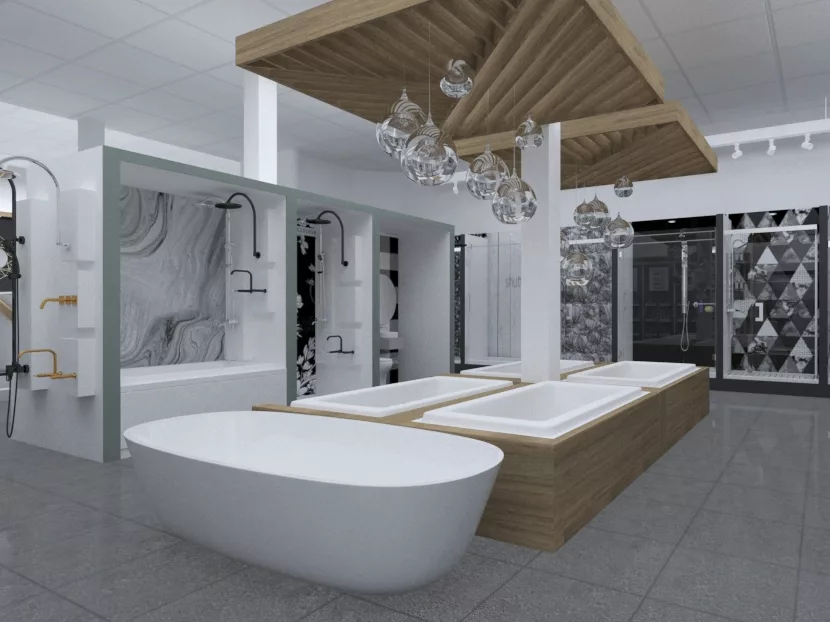In a matter of months, the retail landscape has changed. People are shopping differently and will be for months to come. Line-ups, hand-wash stations, social distancing, signs and new rules in every store — these are all things affecting how people shop during this pandemic. Chances are, it is going to stay like this for a while, and decorative plumbing and hardware showrooms will have to adapt to keep business going strong.
We’ve been speaking with our clients about their experiences these past few months and, overall, the feeling is positive moving forward. As the economy reopens slowly, showrooms expect people to start shopping in-store again — and there’s a good reason for this optimism.
What’s the reason? People are renovating! Houzz did a survey to check in on the remodeling industry and uncovered some interesting info: During the lockdown, 52 percent of people were able to continue their projects. Even more revealing is this: Four out of five homeowners reported they were thinking of making changes so they can enjoy their homes better, and nine in 10 said they plan upgrades for after the pandemic.
Respondents’ wish lists included outdoor projects, kitchens and bathrooms. It makes sense. People have been at home for weeks, taking the time to assess their homes and planning ways to improve them. Not to mention, significant expenses such as vacation trips have been eliminated, so homeowners can now invest more in their homes.
It is a time to take stock in what we have and find ways to improve on all levels. Showrooms have the opportunity to do just that, and it is best to make changes now to accommodate the new normal in consumer behavior and physical retail sales.
Before getting into the specific changes a showroom can make to adapt to a new world, you have to consider how people will shop in the days, months and even years to come.

Clients will expect showrooms to be clean, organized and taking proper safety precautions. This is true for most retail environments, so showrooms will be expected to keep up with the latest health and safety recommendations. It may mean putting up directional signage, but that clutters the space.
With a strategic floor plan, you can implement social distancing practices while selling efficiently. A proper floor plan guides people through the showroom; from the minute they walk in, they’ll know instinctively which way to go. It also keeps directional signage to a minimum; in smaller showrooms, where real estate is needed for products, signs take up too much space.
For now, we expect browsing to be limited for safety reasons, meaning showrooms will be booking appointments to clean between visits. In well-organized and laid-out showrooms, it will be possible to schedule multiple appointments at a time by keeping staff and clients safe in different areas of the showroom.
In this new way of shopping, there is still a chance to let clients try the products — faucets, for example — by sanitizing in between bookings. In these quieter days, take the time to assess your showroom. Do a walk-through, looking at the specific areas and features listed here.
Post-COVID-19 Priorities: Floor Plan and Flow
A showroom’s layout is one of its top selling tools. When done right, customers know exactly where to go and don’t miss a single product. When done wrong, it makes the showroom experience confusing — no one likes to backtrack around a store, searching for that faucet they loved.
The last thing you want in the coming months are customers wandering around, bumping into each other or staff or interacting with products that need sanitizing. Now is the time to control where people go to keep things safe for everyone.
With a proper layout, there will be a flow through the showroom. Flow is about helping clients to transition from space to space, helping them process their experience as they move through the showroom. This allows clients to efficiently analyze, process and make decisions. These days, it’s one of your best tools to keep the showroom organized and comfortable.
Here’s an exercise: Starting at the main entrance, walk through your showroom. If possible, bring someone unfamiliar with the space to give you a fresh perspective. As you walk through, note where the path is taking you. Are displays in the right places? Are there obstacles such as accessory towers blocking the aisles or dead ends? Break out the measuring tape and measure the aisles — walkways of 60 inches or more are recommended for optimal client comfort, especially in these days of social distancing.
Whatever you notice, know that there are ways to improve the flow. Sometimes it’s as simple as moving a few displays around; in other cases, you may decide it’s time to implement a brand-new layout strategy. Either way, your floor plan should be your focus moving forward.
The next step on your walk-through is to look very carefully at every one of your display fixtures — old, new and in-between. You’re checking for damage, of course, but what you want to focus on is consistency. A showroom full of displays in different colors, finishes and styles is a sure-fire way to ruin the customer experience. It creates confusion, discomfort and overwhelms the shopper. Mismatched displays can create such a strong impression that clients may even leave before giving the showroom a chance.
Mismatched displays don’t do showroom owners any favors. They disrupt branding, make it harder for employees to sell and contribute to disorganization, causing showroom owners to lose control of effective showroom selling practices. As showrooms shift to a new normal, beautiful displays can turn the showroom into a kitchen and bath fixture gallery, where products are showcased to their best advantage.
People may not be able to touch, but good displays turn products into eye-candy shoppers won’t be able to resist.
Small Changes Make a Big Difference
Many small changes make a huge difference to clients and staff and don’t require major overhauls. Lighting, safety protocols, air quality and employee comfort are quickly addressed after a little analysis and a few adjustments.
First off, what’s the lighting situation in your showroom? Proper lighting is crucial for everyone, from employees to clients. Assess the ratio of natural to artificial light; both are important, but they need to be maximized. For one, proper lighting can reduce errors by 30 percent, saving you both time and money. It’s also good for your employees; improved lighting can result in a 10 percent increase in productivity.

Natural lighting has a positive effect on buyers. In fact, sales are more likely in spaces with natural light than in those with artificial lighting. It’s also a product’s best friend, so take an inventory of in-display lighting and track or spotlights and make the necessary improvements.
Next, what are the changes you can make so clients feel safe and comfortable? Pre-COVID, a showroom’s take on the customer experience centered around creating a pleasant experience that generated sales. Now, that experience has a lot more to do with cleanliness, convenience and organization, so a customer’s shopping trip stays focused and quick.
The first thing that sets people at ease is the entrance — ensure it is not cluttered and, if possible, offers a view of the whole showroom. You can place lower displays in the center of the showroom and taller ones along the walls to create this open, airy effect.
Another common tactic before the pandemic was to offer seating areas and refreshments. This may be trickier now, or not even possible for health and safety reasons, but there are other options. Create distinct and well-separated sitting areas where clients and employees can meet to discuss products and projects.
Large design tables surrounded by seating may be out, for now, so focus on small tables with chairs spaced at appropriate distances. A showroom focused on customer comfort allows clients to concentrate on what the business has to offer without distractions or concerns over their well-being.
What helps your clients feel safe will help your employees feel safe, too. Since you’re making changes to ensure health and safety, why not take the opportunity to reorganize your employees’ workspaces? Comfortable and organized workplaces have a significant impact on employee performance and productivity levels.
A clean environment, free from clutter helps to remove distractions and improve concentration levels. Let these numbers convince you to make the changes: Companies committed to employee well-being have seen 22 percent higher profitability, 21 percent higher productivity and 37 percent less absenteeism.
Update Now for Future Success
After so long at home, people are craving the experience of in-store shopping, especially in safe, clean retail environments. Those environments are boutique businesses such as decorative plumbing showrooms, which no doubt will feel safer and cleaner than big-box stores. As a more controlled environment, products and people are spaced out. Also, with fewer shoppers and staff members, it will be easier to keep the showroom clean and sanitized — clients understand this and will feel more comfortable.
When they’re choosing where to shop, what will influence their decision to select one showroom over another? We believe shoppers will choose showrooms based on how safe they feel in the space but will also want to get in and out quickly.
If they come into the physical store, chances are they’re committed to buying. It is critical that merchandise is organized strategically and clutter is minimized so clients can find exactly what they’re looking for and make their purchases promptly.
If there’s any time to invest in your showroom, it’s now. Retail has to adapt to a world where people will be spaced out, spaces have to be cleaned and sanitized regularly, and shoppers want to make quick, informed buying decisions. It will be a while until people go back to leisurely browsing, so you want to be sure your showroom is optimized for sales through organized merchandise and a strategic floor plan.






